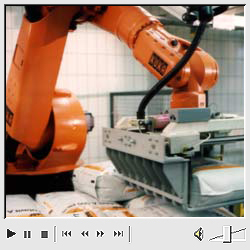|
Handling of animal fodder sacks
Starting point / Task definition
BASF was looking for an automated palletizing solution
for its vitamin A concentrate, which is used primarily
in animal food, but also in food for humans and in pharmaceutical
products. The main reasons for this conversion from
manual to automated handling were a desire for higher
productivity and better working conditions for employees.
Implementation / Solution  The automated system is built around a KUKA KR 125 six-axis
robot equipped with a fork gripper. A decisive criterion
in the selection of this automated system was the floor
space requirement. The space which was available was relatively
small, and was also not very high. During handling operations,
only three centimeters remain between the top of the robot
and the ceiling when the robot reaches its highest position. The automated system is built around a KUKA KR 125 six-axis
robot equipped with a fork gripper. A decisive criterion
in the selection of this automated system was the floor
space requirement. The space which was available was relatively
small, and was also not very high. During handling operations,
only three centimeters remain between the top of the robot
and the ceiling when the robot reaches its highest position.
Originally BASF had planned to use a
palletizing machine, up until then the standard solution
for such applications. The major argument against this,
however, was its height requirement, which would have
necessitated constructing a pit. Besides the additional
expense this would have involved, such a design would
have been questionable from a food technology point
of view, if only because of the difficulty and expense
of cleaning. Additional arguments in favor of the robot
were its short cycle time and good figures with respect
to repeatability and flexibility.
The vitamin A is put into 25 kg sacks.
When preparing shipments that will be sent overseas,
BASF additionally places each sack in a cardboard box.
The sacks and boxes are carried on conveyor belts through
a weighing and labeling station before arriving at the
robot. Just before reaching the robot, the goods are
transferred from the conveyor belt to a roller conveyor.
In this way, the vision system can report to the KR
125 that a container has arrived, and the robot can
reach between the rollers of the conveyor with the forks
of its gripper, and lift the sack without damaging it.
The robot then gently stacks the bag on a pallet, which
is located on the outgoing roller conveyor. The robot
can also handle cardboard boxes using the same fork
gripper that is uses for the sacks.
System components / Scope of supply
KUKA KR 125 robot
PC-based KUKA robot controller, including control panel
with Windows interface
Fork gripper
Incoming and outgoing conveyor systems
Safeguards
Weighing and labeling station
Robot programming
Test setup to verify system functions at an early stage
Commissioning
Supplied by KUKA systems partner Koch-Industrieanlagen
GmbH, Dernbach near Dierdorf, Germany.
Results / Success
High repeatability
The high repeatability of the KR 125
means that it can handle the sacks and boxes gently
and stack them precisely, which plays a large part in
preventing transportation damage.
Remarkable flexibility
Thanks to the robot’s flexibility,
the user can switch quickly at any time between different
container forms and stacking patterns. For example,
the robot “knows” how to make composite
stacks of sacks and column stacks of cardboard containers.
Compared to a conventional palletizer, which sometimes
actually has to be modified in the case of varying containers
or conditions, with the KR 125 all one has to do is
choose the appropriate program from those stored in
the robot controller. To simplify this procedure even
further, BASF had a lever installed which makes it even
easier to select either one of the two standard programs,
even if the operator has practically no prior knowledge
of the system. Other programs are also provided, for
example for varying the number of layers depending on
the forwarding route.
Short cycle time
At a cycle time of ten seconds, the
KR 125 stacks approximately 30 tonnes of vitamin A concentrate
per shift. The capacity of the system is designed for
growth, and a cycle of seven to eight seconds could
be implemented. The gain in productivity from using
a robotic cell becomes apparent if one considers that
palletizing one sack previously took a whole minute.
Rapid payback
Since the introduction of this automated
palletizing system, BASF has required two fewer workers
in this area, thus achieving a relatively short payback
period. The high availability of the robot is also important
here; BASF is reinforcing this by sending some of its
own employees for training by the KUKA systems partner.
|
